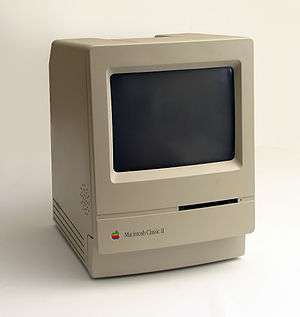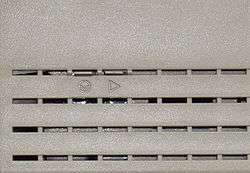Macintosh Classic II
 | |
| Also known as | "Montana"[1] |
|---|---|
| Developer | Apple Computer, Inc. |
| Product family | Compact Macintosh, Performa |
| Release date | October 21, 1991 |
| Introductory price | US$1,900 (equivalent to $3,414 in 2017) |
| Discontinued | October 18, 1993 |
| Operating system |
System 6.0.8L - Mac OS 7.6.1 With a 32-bit clean ROM upgrade, Mac OS 8.0 - Mac OS 8.1 |
| CPU | Motorola 68030 @ 16 MHz |
| Memory | 2 MB, expandable to 10 MB (100 ns 30-pin SIMM) |
| Dimensions |
Height: 13.2 inches (34 cm) Width: 9.7 inches (25 cm) Depth: 11.2 inches (28 cm) |
| Weight | 16 pounds (7.3 kg) |
| Predecessor |
Macintosh SE/30 Macintosh Classic |
| Successor | Macintosh Color Classic |
The Macintosh Classic II (also sold as the Performa 200) is a personal computer designed, manufactured and sold by Apple Computer, Inc. from October 1991 to September 1993. Like the Macintosh SE/30 it replaces, the Classic II was powered by a 16 MHz Motorola 68030 CPU and 40 or 80 MB hard disk, but in contrast to its predecessor, it was limited by a 16-bit data bus (the SE/30 had a 32-bit data bus) and a 10 MB memory ceiling. The slower data bus resulted in the Classic II being 30% slower than the SE/30.[1]
While the Classic II shares a case with the earlier Classic, architecturally it is more similar to the Macintosh LC. The use of custom ICs, identical to those used in the LC, enabled the Classic II to have a lower component count than older Macs. Unlike the LC and the SE/30 before it, the Classic II does not have an internal Processor Direct Slot, making it the first slotless desktop Macintosh since the Macintosh Plus.
The Classic II was one of the three machines Apple repackaged as a Macintosh Performa when the brand was introduced in September 1992.[2] Called the "Performa 200", it was sold with the same specifications as the original Classic II, with the addition of a speaker grille on the left side for enhanced sound. A number of changes to the packaged software were included, such as the At Ease desktop alternative which aimed to provide a simpler user interface than the standard Macintosh Finder. The exact software included tended to vary from one retailer to the next. It was initially offered at a retail price of about $1,250 USD.[2]
The Classic II is the last black-and-white compact Macintosh, and the last desktop Macintosh to include an external floppy disk drive port. Apple discontinued support for the Classic II on January 1, 2001.
Models
Hardware
Processor: 16 MHz (15.6672 MHz) Motorola 68030 (32-bit internally, 16-bit bus), with an optional Motorola 68882 FPU
RAM: 2 MB, expandable to 10 MB using two 100 ns 30-pin SIMMs
Display: 9" b&w screen, 512 x 342 pixels
Audio: 8-bit mono 22kHz
Hard drive: 40 or 80 MB
Floppy: 1.4 MB double sided
Addressing: 24-bit or 32-bit
Battery: 3.6 V lithium
Expansion: Connectors on the rear panel include an ADB port for keyboard and mouse, two mini-DIN-8 RS-422 serial ports, DB-25 SCSI, DB-19 External floppy drive, and two 3.5 mm minijack audio sockets for audio in and headphone out.
The Classic II has a 50-pin internal expansion slot intended for either an FPU co-processor or additional ROM. The socket is not designed to be used for any other purpose and is not suitable for use as a general expansion slot. Apple never produced an expansion card of any kind for this slot,[6] although at least one third-party FPU was available: the FastMath Classic II by Applied Engineering.[7] and Sonnet offered a synchronous (16MHz) and asynchronous (50MHz) 68882 FPU.
In 2016, a group of hobbyists at the 68k Mac Liberation Army forums produced[8] an expansion card with sockets for an FPU and a bootable, rewriteable ROM.
Gallery
 |
Back of the Classic II |
 |
The interrupt (left) and reset (right) buttons protruding from the air vent on the lower left hand side of the Classic II. The interrupt button (also called the programmer's key) is used to access a debugger. |
 |
The Apple ADB keyboard that shipped with the Classic II. On many Macs the large button at the top near the Apple logo was used to power on the machine. However the Classic II did not support this feature. The keyboard contained two ADB connectors. One connected into the back of the Macintosh, the other was used for connecting the mouse or other peripherals. The mouse could be connected to either side for left- or right-handed use. |
 |
The Apple desktop mouse that shipped with the Classic II. |
Timeline of compact Macintosh models

References
- 1 2 Pogue, David; Schorr, Joseph (1999). MacWorld Mac Secrets, 5th Edition. IDG Books. ISBN 0-7645-4040-8.
- 1 2 Seiter, Charles (November 1992). "Mass Market Macs - Apple's New Performa Series Is Coming To A Store Near You". MacWorld Magazine. pp. 110–115.
- ↑ "Macintosh Classic II: Technical Specifications". Apple.
- ↑ "Apple User Group Connection - December 1991". Apple.
- ↑ "Macintosh Performa 200:Technical Specifications". Apple.
- ↑ Macintosh Classic II: Math Co-Processor Card Availability
- ↑ http://www.accessmylibrary.com/coms2/summary_0286-9244729_ITM
- ↑ Classic II FPU/ROM card 68kMLA forum thread
External links
- Classic II (Performa 200)Information pages at Mac512.com
